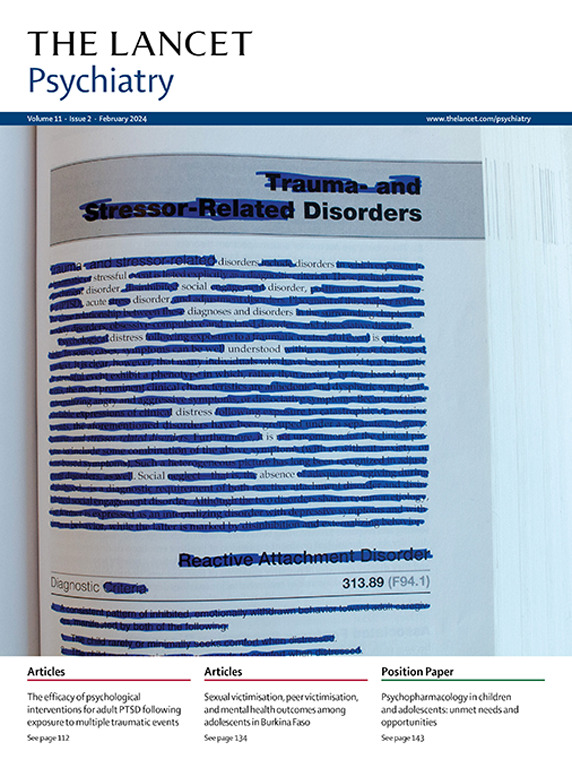Prevalence, correlates, tolerability-related outcomes, and efficacy-related outcomes of antipsychotic polypharmacy: a systematic review and meta-analysis
IF 30.8
1区 医学
Q1 PSYCHIATRY
引用次数: 0
Abstract
Background
Antipsychotic polypharmacy remains a clinical reality, despite an increased risk of adverse events and little evidence of additional efficacy compared with antipsychotic monotherapy. In this systematic review and meta-analysis, we aimed to provide a comprehensive assessment of antipsychotic polypharmacy prevalence, trends, and correlates across mental disorders.Methods
We searched MEDLINE and Embase from Jan 1, 2009 to April 30, 2024, for any original study (observational and interventional) reporting antipsychotic polypharmacy prevalence in populations with mental disorders or use of antipsychotics, regardless of age or diagnosis. Relevant studies before May 1, 2009, were identified from two previous systematic reviews of antipsychotic polypharmacy prevalence. Pooled antipsychotic polypharmacy prevalence was estimated using random-effects meta-analysis. Using subgroup and mixed-effects meta-regression analyses, we sought to identify relevant correlates of antipsychotic polypharmacy. People with lived experience were not involved in the project. This review is registered with PROSPERO (CRD42022329953).Findings
We analysed 517 studies with 599 individual timepoints reporting on 4 459 149 individuals (mean age 39·5 years [range 6·4–86·3]; data on sex and ethnicity were infrequently reported). Most studies included patients with schizophrenia spectrum disorders (SSDs; k=270, 52%). Overall, 24·8% (95% CI 22·9–26·7) of the populations received antipsychotic polypharmacy, ranging from 33·2% (30·6–36·0) in people with SSDs to 5·2% (4·0–6·8) in people with dementia. Antipsychotic polypharmacy prevalence varied by region from 15·4% (95% CI 12·9–18·2) in North America to 38·6% (27·7–50·6) in Africa. Overall antipsychotic polypharmacy prevalence increased significantly from 1970 to 2023 (β=0·019, 95% CI 0·009–0·029; p=0·0002) and was higher in adults than in children and adolescents (27·4%, 95% CI 25·2–29·8 vs 7·0%, 4·7–10·3; p<0·0001) and among inpatients than among outpatients (31·4%, 27·9–35·2 vs 19·9%, 16·8–23·3; p<0·0001). Compared with antipsychotic monotherapy, antipsychotic polypharmacy was associated with an increased risk of relapse (relative risk [RR] 1·42, 95% CI 1·04–1·93; p=0·028), psychiatric hospitalisation (1·24, 1·12–1·38; p<0·0001), worse global functioning (standardised mean difference [SMD] –0·31, 95% CI –0·44 to –0·19; p<0·0001), and more adverse events, including extrapyramidal symptoms (RR 1·63, 95% CI 1·13–2·36; p=0·0098), dystonia (5·91, 1·20–29·17; p=0·029), anticholinergic use (1·91, 1·55–2·35; p<0·0001), higher side-effect scores (SMD 0·33, 95% CI 0·24–0·42; p<0·0001), longer corrected QT interval (0·24, 0·23–0·26; p<0·0001), and greater all-cause mortality risk (RR 1·19, 95% CI 1·00–1·41; p=0·047).Interpretation
The prevalence of antipsychotic polypharmacy has increased globally over the past 50 years and is particularly high in patients with SSDs. Prescription of antipsychotic polypharmacy is associated with greater illness severity and poorer outcomes than is antipsychotic monopharmacy but does not resolve these issues. Furthermore, antipsychotic polypharmacy is associated with higher side-effect burden, including all-cause mortality.Funding
None.抗精神病药多药治疗的流行率、相关性、耐受性相关结果和疗效相关结果:系统回顾和荟萃分析
背景尽管与抗精神病药物单药治疗相比,抗精神病药物多药治疗会增加不良反应的风险,而且几乎没有证据表明其具有额外的疗效,但这仍然是一个临床现实。方法我们检索了 2009 年 1 月 1 日至 2024 年 4 月 30 日期间的 MEDLINE 和 Embase,以查找任何报道精神障碍患者或使用抗精神病药物的人群中抗精神病药物多药滥用流行率的原始研究(观察性和干预性),不论年龄或诊断。2009 年 5 月 1 日之前的相关研究是从之前两篇关于抗精神病药物多药滥用流行率的系统综述中筛选出来的。采用随机效应荟萃分析法估算出抗精神病药物多药合用的总体流行率。通过亚组和混合效应荟萃回归分析,我们试图找出抗精神病药多药滥用的相关因素。有生活经验的人未参与该项目。本综述已在 PROSPERO 注册(CRD42022329953)。研究结果我们分析了 517 项研究,共 599 个时间点,报告了 4 459 149 名患者(平均年龄 39-5 岁 [范围 6-4-86-3];性别和种族数据很少报告)。大多数研究纳入了精神分裂症谱系障碍患者(SSDs;k=270,52%)。总体而言,24-8%(95% CI 22-9-26-7)的人群接受了抗精神病药物多重治疗,其中精神分裂症患者的比例为33-2%(30-6-36-0),而痴呆症患者的比例为5-2%(4-0-6-8)。不同地区的抗精神病药物综合治疗流行率各不相同,北美为 15-4%(95% CI 12-9-18-2),非洲为 38-6%(27-7-50-6)。从1970年到2023年,抗精神病药的总体使用率显著增加(β=0-019,95% CI 0-009-0-029;p=0-0002),成人高于儿童和青少年(27-4%,95% CI 25-2-29-8 vs 7-0%,4-7-10-3;p<0-0001),住院病人高于门诊病人(31-4%,27-9-35-2 vs 19-9%,16-8-23-3;p<0-0001)。与抗精神病药物单药治疗相比,抗精神病药物多药治疗与复发风险增加(相对风险 [RR] 1-42,95% CI 1-04-1-93;p=0-028)、精神病住院(1-24,1-12-1-38;p<0-0001)、整体功能变差(标准化平均差 [SMD]-0-31,95% CI -0-44至-0-19;p<;0-0001),以及更多的不良事件,包括锥体外系症状(RR 1-63,95% CI 1-13-2-36;p=0-0098)、肌张力障碍(5-91,1-20-29-17;p=0-029)、抗胆碱能药物的使用(1-91,1-55-2-35;p<;0-0001)、更高的副作用评分(SMD 0-33,95% CI 0-24-0-42;p<0-0001)、更长的校正 QT 间期(0-24,0-23-0-26;p<0-0001)和更高的全因死亡风险(RR 1-19,95% CI 1-00-1-41;p=0-047)。释义在过去的50年中,全球范围内抗精神病药物多药合用的流行率有所上升,尤其是在SSD患者中。与单一抗精神病药相比,处方抗精神病药多药与疾病的严重程度和预后较差有关,但并不能解决这些问题。此外,抗精神病药多药治疗与较高的副作用负担有关,包括全因死亡率。
本文章由计算机程序翻译,如有差异,请以英文原文为准。
求助全文
约1分钟内获得全文
求助全文
来源期刊

Lancet Psychiatry
PSYCHIATRY-
CiteScore
58.30
自引率
0.90%
发文量
0
期刊介绍:
The Lancet Psychiatry is a globally renowned and trusted resource for groundbreaking research in the field of psychiatry. We specialize in publishing original studies that contribute to transforming and shedding light on important aspects of psychiatric practice. Our comprehensive coverage extends to diverse topics including psychopharmacology, psychotherapy, and psychosocial approaches that address psychiatric disorders throughout the lifespan. We aim to channel innovative treatments and examine the biological research that forms the foundation of such advancements. Our journal also explores novel service delivery methods and promotes fresh perspectives on mental illness, emphasizing the significant contributions of social psychiatry.
 求助内容:
求助内容: 应助结果提醒方式:
应助结果提醒方式:


